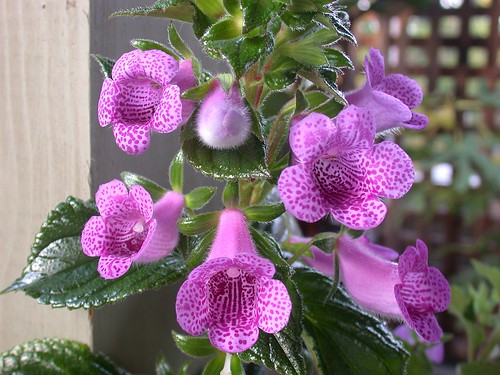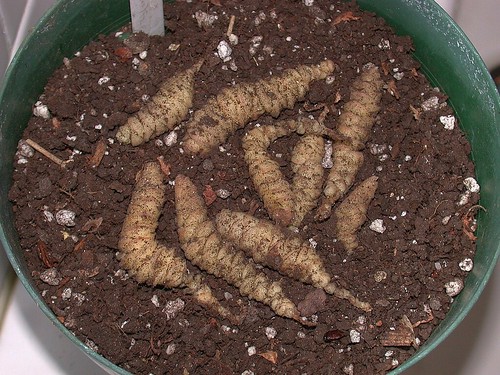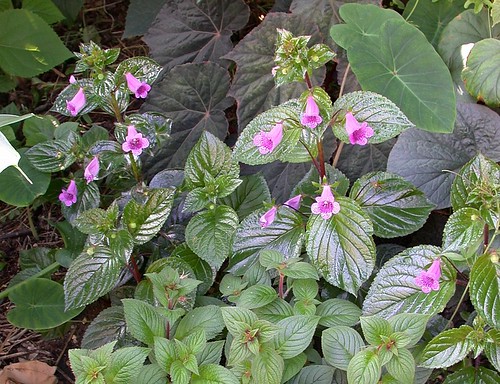What the heck is a ×Gloximannia? (The "×" or multiplication sign, indicating an intergeneric hybrid, is not pronounced.) In a previous blog post I discussed the gesneriad genus Seemannia, a close relative of Gloxinia. Although these two genera look very different, they are closely enough related that their respective species can be easily crossed to produce viable hybrids. And what do you get if you cross the two genera? The nothogenus (hybrid genus) ×Gloximannia, of course. To the best of my knowledge, only Gloxinia perennis has been used from that genus and the hybrids tend to take after this parent. Neither of the other two species--Gloxinia erinoides and Gloxinia xanthophylla--have yet been crossed with any Seemannia species; it would be very interesting to see how such hybrids would turn out.
The first ×Gloximannia hybrids were produced by Gesneriad Society legend Frances Batcheller in the late 1970's, but at the time Seemannia was included in Gloxinia and they were simply considered Gloxinia hybrids. At least one of these, ×G. 'Arion' (Seemannia 'Medusa' x Gloxinia perennis), is still around. In the 1980's I produced my own ×Gloximannia hybrids by crossing Gloxinia perennis with Seemannia (then Gloxinia) 'Chic'. These were spectacularly ordinary plants and not worth naming. They weren't improvements on either parent and I never gave much thought to such hybrids again until Dale Martens, a prolific gesneriad hybridizer, shared with me a small rhizome of her latest hybrid, ×Gloximannia 'She's Dancing', at a Gesneriad Society convention in 2009.
During the first year I grew this plant, I have to confess I wasn't impressed. The plant took a long time to get established (largely due to neglect on my part) but eventually grew into a plant with handsome, glossy dark green foliage and an ever-elongating stem with large purple flowers with darker purple spots. The flowers were attractive, but grown indoors under fluorescent lights the plant was weak-stemmed and floppy. By the time it finally went dormant in mid-winter it had produced three very large rhizomes and several smaller ones, so I saved them and decided to give it another chance the following year. This time I planted the three largest rhizomes together in one large pot to grow outdoors on my rooftop deck, and the smaller rhizomes individually to grow indoors under lights. The difference between the two groups of plants was amazing. The indoor plants grew much like the one I grew the previous year, and started to bloom in late summer. But the outdoor plants, which received several hours of direct morning sun with very bright indirect light the rest of the day, grew bigger, and bigger, and bigger, and didn't start setting buds until about the same time the indoor plants were already blooming. These large, stocky plants produced far more flowers and continued to bloom for a very long period, eventually growing to almost 3 feet tall.

Flowers on ×G. 'She's Dancing' grown outdoors
When I showed photos to Dale she was shocked by its size, saying it had never grown nearly that large for her, but other growers later corroborated my results. The secret seems to lie in the size of the rhizome: plants grown from small rhizomes, rhizome sections, or individual scales (a common way of propagating scaly rhizomatous gesneriads in quantity) will stay relatively small, but plants grown from large rhizomes will grow much larger. Dale was probably so excited by her new hybrid and anxious to share it that she propagated it by breaking up the rhizomes. This demonstrates why many scaly rhizomatous (and other) gesneriads, which may bloom in their first year from seed, can't be judged for their full potential until they've been grown through two or more growing seasons.

Scaly rhizomes of × Gloximannia 'She's Dancing'
Dale reports that she produced ×Gloximannia 'She's Dancing' by crossing Gloxinia perennis with an unnamed Seemannia hybrid (S. gymnostoma × S. purpurascens). Gloxinia perennis has fragrant flowers, a fairly unusual characteristic among its relatives. Dale has been working to produce fragrant hybrids in several different genera, and her goal in this cross was to produce a fragrant hybrid. According to Dale, the other seedlings from the cross were weak and this was the only one to grow to maturity and bloom. Although the flowers had no fragrance, they turned out to be larger
than those of either parent, and covered with large purple spots.
(photo courtesy of Dale Martens)

×Gloximannia 'She's Dancing' (l) with its Seemannia parent (r)
(photo courtesy of Dale Martens)
Dale tells me, "When the first flower opened in December of 2008, I screamed, 'Yippee!' then started my Happy Hybridizer's Dance. Then called my husband into the plant room to see it. I was shocked at how large the seedling's flower was. There was no scent that day or on subsequent days, but that was my only disappointment with the new seedling. The name for this seedling was inspired by my Happy Hybridizer's Dance which is where I do the 1960's dance, the 'twist' while doing 'jazz' hands."
I've tried growing ×Gloximannia 'She's Dancing' in different ways and under different conditions. Because of its height and high light requirements it simply isn't suitable for growing under fluorescent lights indoors but I've found it does well as a container plant outdoors. To my great surprise, a pot I left outdoors on my roof deck all winter sprouted a new plant the next spring, suggesting 'She's Dancing' may have some degree of hardiness if given good drainage and dry winter conditions. It can also be used as a bedding plant in bright shade or part sun.

×Gloximannia 'She's Dancing' in a garden bed
Inspired by Dale's success, I decided to attempt some ×Gloximannia hybrids of my own, using dark-leafed hybrids from my Seemannia breeding program in hopes of producing flowers like those of 'She's Dancing' on plants with dark glossy foliage. Unlike Dale's hybrid my crosses had S. nematanthodes 'Evita' in their background, so I hoped they might have some degree of hardiness. But once again, although I did get some dark-leafed hybrids, my results were spectacularly ordinary. The plants were attractive enough, but simply not different or distinct enough to merit naming, and not one of them had the distinct purple spotting of 'She's Dancing' that I liked so much. I gave them one more chance by leaving them in the ground over the winter, and not one of them returned the following spring. Oh well, you win some, you lose some. Dale is the clear winner of this round!

Unnamed ×Gloximannia hybrid



No comments :
New comments are not allowed.